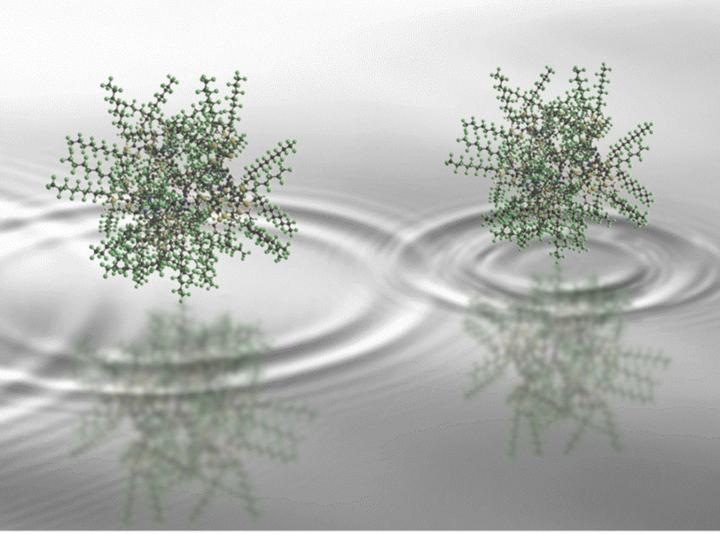2,000 atoms in two places at once

Artistic illustration of the delocalization of the massive molecules used in the experiment. Credit: © Yaakov Fein, Universität Wien Usage Restrictions: The image may only be used with appropriate caption or credit.
The quantum superposition principle has been tested on a scale as never before in a new study by scientists at the University of Vienna in collaboration with the University of Basel.
Hot, complex molecules composed of nearly two thousand atoms were brought into a quantum superposition and made to interfere.
By confirming this phenomenon – “the heart of quantum mechanics”, in Richard Feynman's words – on a new mass scale, improved constraints on alternative theories to quantum mechanics have been placed. The work will be published in Nature Physics.
Quantum to classical?
The superposition principle is a hallmark of quantum theory which emerges from one of the most fundamental equations of quantum mechanics, the Schrödinger equation.
It describes particles in the framework of wave functions, which, much like water waves on the surface of a pond, can exhibit interference effects. But in contrast to water waves, which are a collective behavior of many interacting water molecules, quantum waves can also be associated with isolated single particles.
Perhaps the most elegant example of the wave nature of particles is the double-slit experiment, in which a particle's wave function simultaneously passes through two slits and interferes.
This effect has been demonstrated for photons, electrons, neutrons, atoms and even molecules, and it raises a question that physicists and philosophers have struggled with since the earliest days of quantum mechanics: how do these strange quantum effects transition into the classical world with which we are all familiar
Experimental approach
The experiments by Markus Arndt and his team at the University of Vienna approach this question in the most direct way possible, that is, by showing quantum interference with ever more massive objects.
The molecules in the recent experiments have masses greater than 25,000 atomic mass units, several times larger than the previous record. One of the largest molecules sent through the interferometer, C707H260F908N16S53Zn4, is composed of more than 40,000 protons, neutrons, and electrons, with a de Broglie wavelength that is a thousand times smaller than the diameter of even a single hydrogen atom.
Marcel Mayor and his team at the University of Basel used special techniques to synthesize such massive molecules that were sufficiently stable to form a molecular beam in ultra-high vacuum. Proving the quantum nature of these particles also required a matter-wave interferometer with a two-meter long baseline that was purpose-built in Vienna.
Alternative quantum models and macroscopicity
One class of models which aims to reconcile the apparent transition from a quantum to a classical regime predicts that the wave function of a particle spontaneously collapses with a rate proportional to its mass squared.
By experimentally showing that a superposition is maintained for a heavy particle for a given length of time therefore directly places bounds on how often and how localized such a collapse process can be. In these experiments the molecules remained in a superposition for more than 7 ms, long enough to set new interferometric bounds on alternative quantum models.
A generalized measure called macroscopicity is used to classify just how well alternative models are ruled out by such experiments, and the experiments of Fein et al. published in Nature Physics indeed represent an order of magnitude increase in macroscopicity.
“Our experiments show that quantum mechanics, with all its weirdness, is also amazingly robust, and I'm optimistic that future experiments will test it on an even more massive scale,” says Fein. The line between quantum and classical is getting blurrier all the time.
###
Publication in Nature Physics
“Quantum superposition of molecules beyond 25 kDa”, Y. Y. Fein, P. Geyer, P. Zwick, F. Kia?ka, S. Pedalino, M. Mayor, S. Gerlich, and M. Arndt, Nat. Phys. (2019). doi: 10.1038/s41567-019-0663-9; https:/
Media Contact
All latest news from the category: Life Sciences and Chemistry
Articles and reports from the Life Sciences and chemistry area deal with applied and basic research into modern biology, chemistry and human medicine.
Valuable information can be found on a range of life sciences fields including bacteriology, biochemistry, bionics, bioinformatics, biophysics, biotechnology, genetics, geobotany, human biology, marine biology, microbiology, molecular biology, cellular biology, zoology, bioinorganic chemistry, microchemistry and environmental chemistry.
Newest articles

Combining robotics and ChatGPT
TUM professor uses ChatGPT for choreographies with flying robots. Prof. Angela Schoellig has proved that large language models can be used safely in robotics. ChatGPT develops choreographies for up to…

How the Immune System Learns from Harmless Particles
Our lungs are bombarded by all manner of different particles every single day. Whilst some are perfectly safe for us, others—known as pathogens—have the potential to make us ill. The…

Biomarkers identified for successful treatment of bone marrow tumours
CAR T cell therapy has proven effective in treating various haematological cancers. However, not all patients respond equally well to treatment. In a recent clinical study, researchers from the University…





















